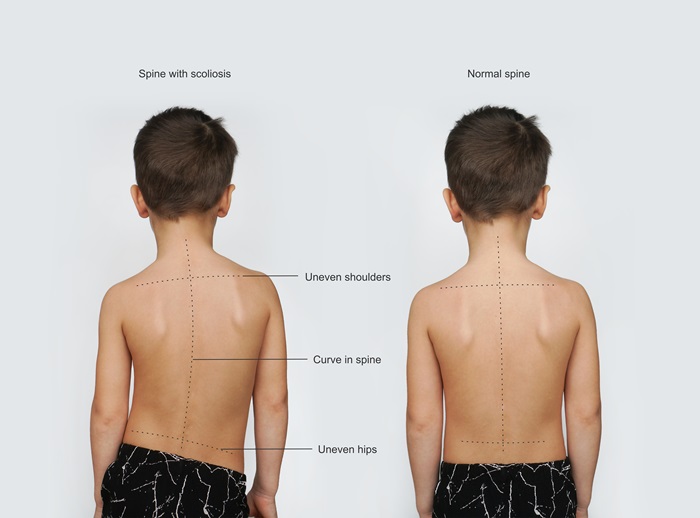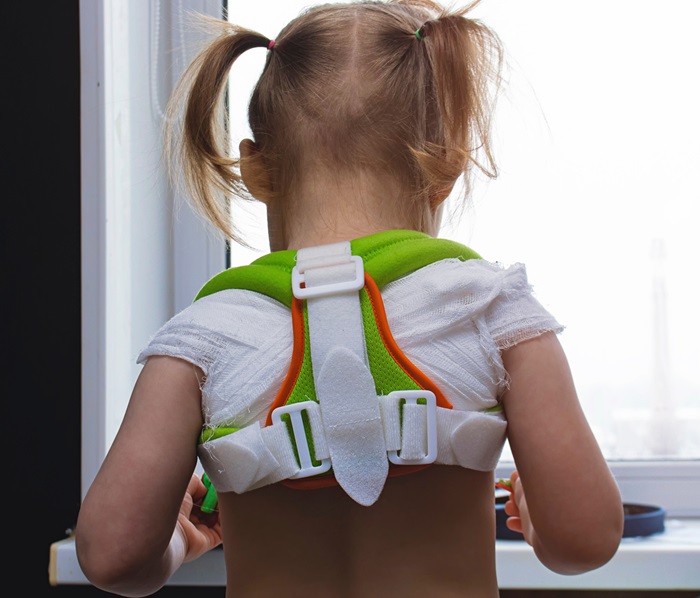Scoliosis in children is a medical condition characterized by an abnormal side-to-side spine curvature, often forming an “S” or “C” shape. While a normal spine appears straight when viewed from behind, a child with scoliosis may seem to lean to one side. This curvature can occur on either side of the spine and may affect the thoracic (middle) and lumbar (lower) regions. Early diagnosis and prompt intervention are crucial to managing this condition effectively.
Let’s understand the reasons, symptoms, diagnosis, and treatment options for scoliosis in children, providing parents with the information they need to support their child’s bone health.

There are three main types of scoliosis:
Born With It or Congenital Scoliosis: It Happens because of spine bones forming incorrectly before birth
Scoliosis With No Known Cause or Idiopathic Scoliosis: It is the most common type, but the cause is still being researched actively
Scoliosis Linked to Other Conditions or Neuromuscular Scoliosis: It happens in people with certain nerve or muscle conditions
The cause of scoliosis in children is often unknown, a condition called idiopathic scoliosis. However, several factors may contribute to its development:
Scoliosis is most commonly diagnosed in children between 10 and 18 and tends to affect more girls than boys.
Recognising the symptoms of scoliosis in the early phase is vital for effective intervention. The following are common signs of scoliosis in children:
These symptoms may vary in severity and may resemble other back problems. Therefore, it’s essential to consult a doctor for an accurate diagnosis.
The doctors will perform a comprehensive analysis to diagnose scoliosis, which includes:
Early detection is crucial, as untreated scoliosis can lead to breathing difficulties and eventually excessive load on the heart.
The treatment approach for scoliosis depends on several factors, including the child’s age, the severity of the curve, and the potential for progression. The following are the common scoliosis treatment options:

Scoliosis in children is a manageable condition when detected early and treated appropriately. Parents play a crucial role in recognising the early signs of scoliosis and seeking medical advice. Children with scoliosis can lead active, healthy lives with the proper intervention. Keeping up with regular check-ups and following treatment plans are essential for preventing complications and ensuring the best outcomes.
Scoliosis can range from mild to severe. While mild cases may require only observation, severe scoliosis can lead to complications affecting the heart and lungs if left unattended. A timely diagnosis and proper treatment are crucial to manage the condition effectively.
Scoliosis does not typically resolve on its own, but with proper treatment, its progression can be halted or significantly slowed. In some cases, mild scoliosis may not progress and may not require treatment.
Many children with scoliosis live normal, active lives. Treatment can help manage symptoms and prevent their progression, allowing individuals to maintain their quality of life.
The best scoliosis treatment depends on the severity of the spine curve and the child’s age. Options include observation, bracing, and surgery. A doctor recommends the most suitable treatment based on individual needs.
Categories: Orthopedics
Early Signs of Scoliosis in Children: What Parents Should Watch For is available for appointments. Please fill the below form to book an appointment.
Unlock the door to exceptional healthcare, book an appointment with SPARSH Hospital and let your journey to wellness begin.